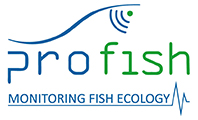The habitat use of marine fish and mammals is of particular importance for the definition of maine protected areas (MPA) but also for the location of offshore wind farms. Despite this interest, the habitat requirements of many of these animals are still largely unknown. Telemetrical studies can give a direct insight into the behavior of fish and marine mammals and thus help to close this gap of knowledge. Our team is specialized in such investigations and masters a variety of telemetric methods and equipment (acoustic telemetry, pop-up archiving & PIT tagging).
In the case of acoustic telemetry, we tag fish with acoustic (ultrasound) transmitters, that then can be located via deployed hydrophones in the study area. Typical results of such studies include visualizations of used habitats (maps) as well as estimates of site fidelity such as the length of residence times and returning rates.
Pop-up archival tags provide information on the habitat and migratory behaviour of (pelagic) fish but are also used to estimate the mortality rates of discard (e.g. in the tropical tuna fisheries). These tags do not allow an active tracking of tagged fish, but transmit their recorded data after detachement to a satellite. Deployment durations are usually less than 1 year.
PIT tags allow the automatic identification of re-introduced fish and are therefore widely used in the context of Capture-Recapture experiments to determine fishing mortality.









 Partager ce contenu
Partager ce contenu